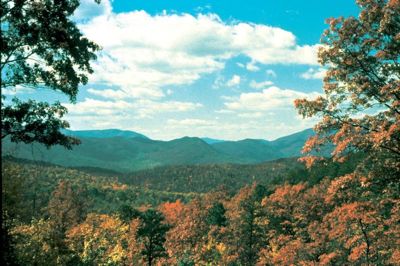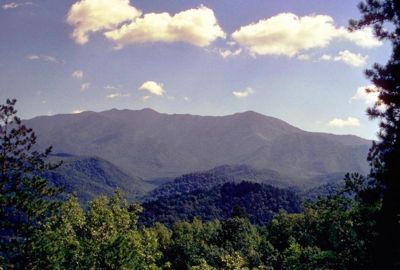
Hemlock woolly adelgid threatens Smokies
CHEROKEE, N.C. – An invasive insect called the hemlock woolly adelgid is prominent in many national parks, but specifically in the Great Smoky Mountains National Park located on the Tennessee-North Carolina border.
The hemlock woolly adelgid feeds on hemlock trees from the root causing the entire tree to die.
The Great Smoky Mountains National Park is made up of mostly hemlock trees; therefore the death of these trees is detrimental to the entire ecosystem.
|
Indian Creek Falls in Great Smoky Mountains National Park is a 1.6 mile round trip. The falls are 25 feet high (Photo courtesy of National Park Service).
|
 |
The hemlock trees bring the temperature down almost eight degrees, which allows many of the parks species to survive and thrive in this specific environment. These trees are particularly large, so they provide shade to the animals that live in the waterways as well.
Environmental scientist Jill Harrington, located in the New York area, commented on this issue after doing research on the decline of National Park ecosystems around the U.S., noting the severity of the problem.
“The hemlock trees are dying at an alarming rate and we can see the negative impact it has on the ecosystem vey easily.” Harrington discovered that the hemlock trees bring the temperature down 3 degrees, allowing many of the parks animals to survive.
Many photographs taken in the GSMNP clearly show the large amounts of hemlock trees that stand dead amidst breathtaking mountains and wildlife. These images bring this problem to light.
 |
The mountains in Great Smoky Mountains National Park are often hazy (Photo courtesy of the National Park Service). |
“As an environmental scientist I think it is crucial that this invasive species is controlled as it effects more than one national park in the U.S.,” said Harrington.
A lab staff member at Bartlett Tree Experts, which have locations all over the US and Canada, is very familiar with the effect that hemlock woolly adelgids have on the ecosystem in Great Smoky Mountains National Park.
Carol Sullivan, a staff member at the North Carolina location, discussed the topic extensively and shared her findings.
“Hemlock woolly adelgids are very hard to avoid in the eastern region, whereas in the west, they are easily avoided.”
The GSMNP is the most visited national park in the United States with more than 9.4 million recreational visits in 2010 according to National Park Service statistics. Because of this, it is crucial that these pests are eliminated.
| At right, fall colors in the park. Below, the park in summer (Photos courtesy of the Natonal Park Service). |  |
Sullivan discussed, in her research, a few methods that can control the hemlock woolly adelgid including horticultural oil, soap, and registered pesticides. “ The efforts to find new control methods have gone up as we have seen the insects are more destructive than they have ever been,” said Sullivan.
Despite this, these methods are not always practical in a large forest environment, such as the GSMNP. These methods are more successful in a landscape situation; therefore it will take more research and planning to control these insects in our national parks.
Sarah Ugerman, a Tennessee resident, has visited this park almost every year since she was the age of 6. Ugerman expressed the true issue that the park is facing.
“We aren’t just losing trees, we are losing wildlife on a daily basis. This park is home to so many different types of animals and they are unable to live in the environment because of the dying trees,” Ugerman stated.
 Caleb Savage, now a Lake Francis State Park interpreter, started out at the GSMNP after college also as an interpreter. Savage’s focus was on wildlife and securing the wild boar that roam the park, as they needed to be under supervision on a daily basis.
Caleb Savage, now a Lake Francis State Park interpreter, started out at the GSMNP after college also as an interpreter. Savage’s focus was on wildlife and securing the wild boar that roam the park, as they needed to be under supervision on a daily basis.
“Many animals that used to roam around camp sites and throughout the park are no longer seen. While I was working there they were working to bring back animals that used to be common to the park, but we were only able to bring back one at that time.”
A total of 65 mammals are native to the GSMNP, although many others have come and gone over the past decade due to the changing of the ecosystem.
The good news is that more than 3,500 people volunteer to work in the park each year, amounting to more than 120,000 hours of work simply to keep the park clean and safe for the millions of people that visit each year.
With the efforts of the volunteers along with the hard work from the staff, the GSMNP will continue to thrive and work through the obstacles.
If You Go
The Great Smoky Mountains National Park is open 24 hours a day, 365 days a year. Some parts of the park are only open during specific seasons.
Cades Cove Visitor Center
- Hours change several times during the year:
- January: 9 a.m. – 4:30 p.m.
- April- August: 9 a.m. – 7 p.m.
Oconatuftee Visitor Center
- Hours change several times during the year:
- January: 9 a.m. – 4:30 p.m.
- April- August: 9 a.m. – 7 p.m.
Sugarlands Visitor Center
- Hours change several times during the year:
- January: 9 a.m. – 4:30 p.m.
- April- August: 9 a.m. – 7 p.m.
Historic Gristic Mills are open from March 12 through the Sunday following Thanksgiving, 9 a.m. – 5 p.m.
Be sure to check out the many activities to do in and around the Great Smokys. From auto touring, bicycling, camping, horseback riding, to wildlife viewing, there is never a dull moment.
Contact by phone at: 865-436-1200 or visit the website at http://www.nps.gov/grsm/index.htm
Be sure to download the free Smokys Mobile App, which allows you to plan your trip and look at the map of the park without cell service.

Comments are Closed